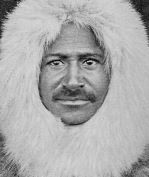 by Emma Bonanomi (2021)
by Emma Bonanomi (2021)
MATTHEW ALEXANDER HENSON (1866-1955) was a Black American explorer who came to fame after United States Navy Commander Robert E. Peary’s 1908-1909 expedition to the North Pole. He may have been one of the first men to reach the North Pole on April 6, 1909, alongside Peary and Inuit guides Odaq, Egingwah, Ooqueah, and Seegloo. In 1912, he published A Negro Explorer at the North Pole, a first-hand account of Peary’s expeditions. Henson’s memoir is intriguing because it combines traditions of exploration literature, sea literature, and Black American autobiography of the period to document Henson’s crucial roles in Peary’s Arctic expeditions, while demonstrating Black ability, valor, cooperation, and accomplishment at a time of widespread racial prejudice. Despite this work, Henson’s achievements and many contributions to Peary’s polar expeditions went largely unrecognized upon his return to the United States due to his race, and much of his popular recognition—as the foremost Black American explorer of his era—was achieved posthumously.
Henson was born in Maryland on August 8, 1866. He first traveled to sea at the age of 12 working aboard the Katie Hines, aboard which he would see a good part of the world, including voyages to the North Pacific and Asia. In 1887, when Henson was 18, Peary hired him as a “valet” for a canal surveying trip to Nicaragua, but he soon proved himself highly skilled in other areas. When Henson first traveled to Greenland as Peary’s assistant in 1891, he became close with a group of Inuit who took him under their tutelage. He picked up the Inuktitut language quickly, and on six subsequent expeditions to the Arctic, he served as a translator and liaison between Peary and the Inuit hunters and seamstresses in his employ. George Borup, another of Peary’s assistants on the 1908-1909 North Pole trip, called Henson “a jack-of-all-trades, and differing from that person in being apparently a master of them all; a dandy sledge maker, good shot, and as good a dog driver as the best Eskimos.” A third expedition member, Donald MacMillan, recalled, “Henson… was of more real value to our Commander than [expedition members] Bartlett, Marvin, Borup, Goodsell and myself all put together. Matthew Henson went to the Pole with Peary because he was a better man than any one of us.”
When Henson returned to the United States in October 1909, severe racism denied him many of the accolades awarded Peary and other white members of the expedition. Henson—who had earned $50 a month on the North Pole expedition—embarked on a lecture tour against Peary’s wishes to make money to support himself. When the tour ended early due to heavy financial losses, Henson’s options were limited. He had devoted his adult life to his work with Peary, touring with dog teams between expeditions to raise money for future Arctic travel. When Henson returned to New York, he took a job parking cars in a Brooklyn garage. In 1913, President Taft appointed him to a civil service position with the U.S. Customs House, where he would work until his retirement at the age of 70.
Henson’s account of the North Pole trip, A Negro Explorer at the North Pole (1912), reflected and contended with the complex and often contradictory notions of race and national identity at play in Jim Crow America. An introduction from Booker T. Washington situated Henson’s Arctic endeavors within a broader narrative of racial achievement reminiscent of post-Civil War Black American autobiographies, while a forward, from Peary, spoke to the perceived necessity by the white publishing industry of a formal authentication of the Black author by the prominent white commander. Organized chronologically, Henson’s narrative provided an overview of his experiences at sea from his time on the Katie Hines through the expedition’s attainment of the Pole and the S.S. Roosevelt’s return to the United States, drawing on Henson’s expedition diaries.
In later life, Henson was recognized with honorary degrees, awards, and eventually belated membership in the Explorers Club. Still, the acknowledgement offered Henson was erratic, and from 1928 until his death in 1955, Henson lived with his wife in a humble apartment on West 150th Street in New York, on a pension of $85 a month. True recognition of Henson as a skilled explorer in his own right came only decades following his death. In 1988, Harvard professor S. Allen Counter successfully lobbied to have Henson and his wife, Lucy Jane Ross, reinterred from Woodlawn Cemetery in the Bronx to Arlington National Cemetery.
A Negro Explorer at the North Pole (1912)
Project Gutenberg
Google Books
“The Negro at the North Pole: The Story of the Last Dash, Told by Commander Peary’s Only American Companion at the Top of the Earth.” The World’s Work: A History of Our Time. XIX: 12825–12837 (April 1910).
“Matt Henson Tells the Real Story of Peary’s Trip to the Pole,” Boston American (July 17, 1910).
Further Studies
Bradley Robinson with Matthew Henson. Dark Companion: The Story of Matthew Henson. New York: K.M. McBride, 1947.
Emma Bonanomi, “To Be Black and American: Matthew Henson and His Post-Pole Lecture Tour, 1909-1910.” North by Degree: New Perspectives on Arctic Exploration. Philadelphia: American Philosophical Society, 2013, pp. 185-209.
Allen Counter. North Pole Legacy: Black, White & Eskimo. Amherst: The University of Massachusetts Press, 1991.
Ward McAfee. “The Travail of Matthew Henson.” Phylon, 4, 1975, pp. 407-10.
Anthony S. Foy, “Matthew Henson and The Antinomies Of Racial Uplift,” a/b: Auto/Biography Studies, 27:1, 2012, pp. 19-44.
Peary-MacMillan Arctic Museum, “Matthew Alexander Henson, Virtual Exhibit,” Bowdoin College, Brunswick, Maine, February 2021.
George Liston Seay and Edna Greene Medford. “Discovering Matthew Henson.” Dialogue television program. Wilson Center, 2011.
Gail Saltz and Kat Long, Matthew Henson: Courageous Discoverer Despite Racism, Personology Podcast, March 29, 2021. (click on title to listen to podcast)
